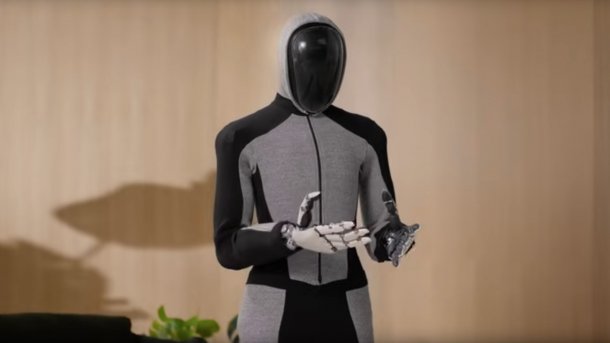1X shows humanoid robot Neo for domestic use
1X is targeting private households with its humanoid robot. But they first have to be able to afford the robot.

The Neo from 1X is designed to help with household chores.
(Image: 1X (Screenshot))
Robotics company 1X, a spin-off of Sam Altman's AI company OpenAI, is taking a different approach with its new humanoid robot Neo than the majority of its competitors, such as Tesla, Figure or Boston Dynamics. Instead of building a humanoid robot for use in industry and preparing it for use there, Neo focuses on use in the home. However, anyone who believes that the robot will soon be running around in households worldwide will be disabused: 1X assumes that this will only be the case in "a few years". Accordingly, the robot is still explicitly identified as a beta model in development.
The humanoid robot Neo from 1X is a further development of the semi-humanoid robot Eve, which has a humanoid upper body with arms, but moves forward on a rolling platform. Neo is different. He is a "real" humanoid robot with legs.
However, 1X does not reveal much about the technology used. There are just a few key facts about the robot. It is around 165 cm tall and weighs around 30 kg. This is significantly less than other humanoid robots: for comparison, Tesla Optimus Gen2 weighs 57 kg and Figure 02 weighs as much as 70 kg. Only Unitree's G1, which is also significantly smaller, comes closer to the weight of the 1X at 35 kg. However, the direction of travel for the other robots is also clear: they are designed for industrial use and need to be much more stable to survive in robust working environments.
Soft and compliant
Neo, on the other hand, has been developed for domestic use. Accordingly, it is in closer contact with people much more frequently and must meet different criteria in terms of product safety. Accordingly, it has to be softer than its industrial counterparts. This is not only noticeable in the lower weight, but also in the basic construction of the robot. Although the skeleton is largely made of aluminum parts, they are often encased in a plastic cage, over which the developers have placed a soft, partially padded fabric suit. Accidental collisions with Neo are therefore less painful.
The extremities can also be stretched. The robot therefore gives way when it hits an obstacle or a person. Neo achieves this by using actuators that are modeled on muscles. The company is not saying exactly what the actuators look like. This is not surprising, as actuators are a key technology for robots. Their strength and responsiveness determine how quickly and smoothly a robot can move. Neo is therefore rarely seen undressed and in videos the actuators, especially those in the wrists, are always pixelated when they are exposed. 1X seems to want to protect the development work for as long as possible. Only one thing is known about the performance of the actuators: The robot should be able to handle objects weighing up to 25 kg with its five-fingered hands, which is almost as much as the robot's own weight. The individual fingers are said to be equipped with touch-sensitive sensors so that Neo can grip sensitively.
Empfohlener redaktioneller Inhalt
Mit Ihrer Zustimmmung wird hier ein externes YouTube-Video (Google Ireland Limited) geladen.
Ich bin damit einverstanden, dass mir externe Inhalte angezeigt werden. Damit können personenbezogene Daten an Drittplattformen (Google Ireland Limited) übermittelt werden. Mehr dazu in unserer Datenschutzerklärung.
1X certifies that the robot is highly mobile. It is said to walk at speeds of up to 4 km/h. The maximum running speed is said to be 12 km/h. The integrated rechargeable batteries keep the Neo robot alive for between two and four hours.
However, Neo still has a lot to learn before it can be used in the home. This is because the robot can only be delivered when it can move around the household safely and has mastered enough techniques to be put to good use there. It could be several years before that happens. Bernt Øivind Børnich, CEO of 1X, assumes that it could be between 2027 and 2030. However, the price of the robot has not yet been determined. Børnich is talking about a price range similar to that of a small car today.
(olb)